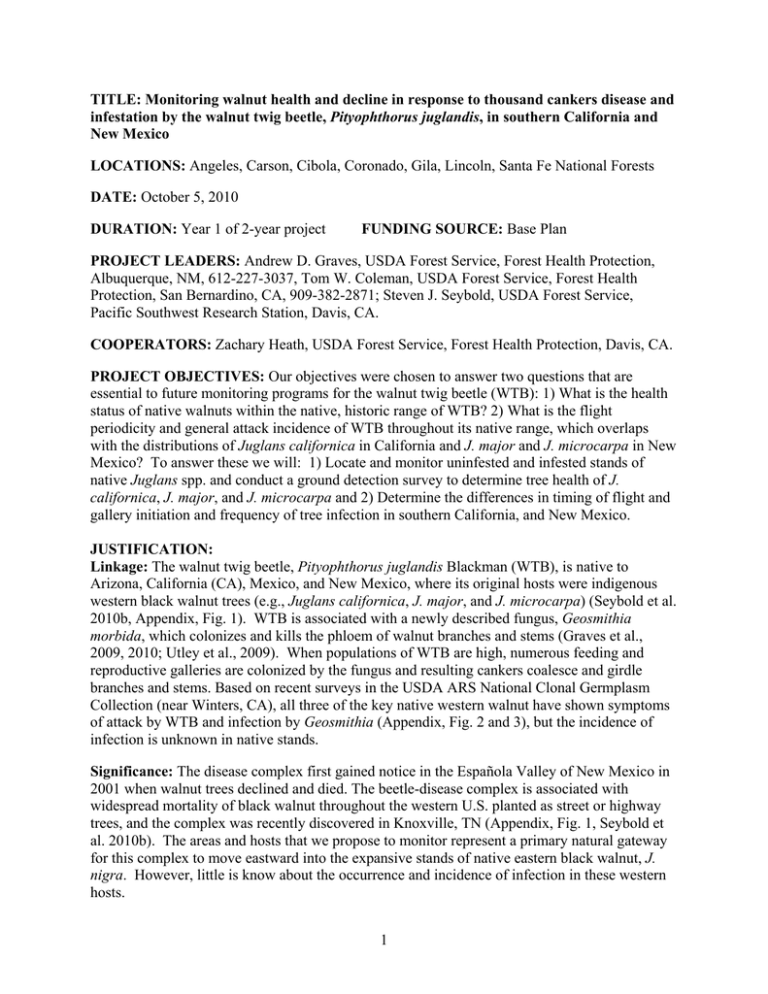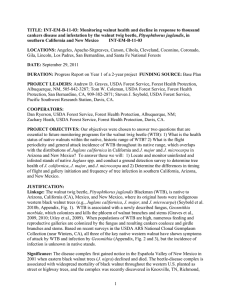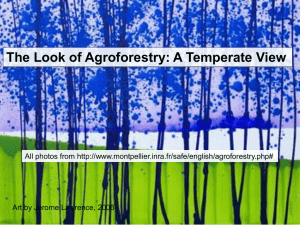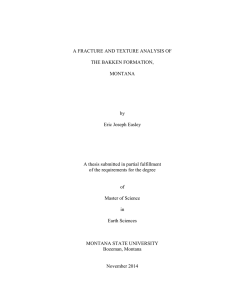TITLE: Monitoring walnut health and decline in response to thousand... Pityophthorus juglandis
advertisement

TITLE: Monitoring walnut health and decline in response to thousand cankers disease and infestation by the walnut twig beetle, Pityophthorus juglandis, in southern California and New Mexico LOCATIONS: Angeles, Carson, Cibola, Coronado, Gila, Lincoln, Santa Fe National Forests DATE: October 5, 2010 DURATION: Year 1 of 2-year project FUNDING SOURCE: Base Plan PROJECT LEADERS: Andrew D. Graves, USDA Forest Service, Forest Health Protection, Albuquerque, NM, 612-227-3037, Tom W. Coleman, USDA Forest Service, Forest Health Protection, San Bernardino, CA, 909-382-2871; Steven J. Seybold, USDA Forest Service, Pacific Southwest Research Station, Davis, CA. COOPERATORS: Zachary Heath, USDA Forest Service, Forest Health Protection, Davis, CA. PROJECT OBJECTIVES: Our objectives were chosen to answer two questions that are essential to future monitoring programs for the walnut twig beetle (WTB): 1) What is the health status of native walnuts within the native, historic range of WTB? 2) What is the flight periodicity and general attack incidence of WTB throughout its native range, which overlaps with the distributions of Juglans californica in California and J. major and J. microcarpa in New Mexico? To answer these we will: 1) Locate and monitor uninfested and infested stands of native Juglans spp. and conduct a ground detection survey to determine tree health of J. californica, J. major, and J. microcarpa and 2) Determine the differences in timing of flight and gallery initiation and frequency of tree infection in southern California, and New Mexico. JUSTIFICATION: Linkage: The walnut twig beetle, Pityophthorus juglandis Blackman (WTB), is native to Arizona, California (CA), Mexico, and New Mexico, where its original hosts were indigenous western black walnut trees (e.g., Juglans californica, J. major, and J. microcarpa) (Seybold et al. 2010b, Appendix, Fig. 1). WTB is associated with a newly described fungus, Geosmithia morbida, which colonizes and kills the phloem of walnut branches and stems (Graves et al., 2009, 2010; Utley et al., 2009). When populations of WTB are high, numerous feeding and reproductive galleries are colonized by the fungus and resulting cankers coalesce and girdle branches and stems. Based on recent surveys in the USDA ARS National Clonal Germplasm Collection (near Winters, CA), all three of the key native western walnut have shown symptoms of attack by WTB and infection by Geosmithia (Appendix, Fig. 2 and 3), but the incidence of infection is unknown in native stands. Significance: The disease complex first gained notice in the Española Valley of New Mexico in 2001 when walnut trees declined and died. The beetle-disease complex is associated with widespread mortality of black walnut throughout the western U.S. planted as street or highway trees, and the complex was recently discovered in Knoxville, TN (Appendix, Fig. 1, Seybold et al. 2010b). The areas and hosts that we propose to monitor represent a primary natural gateway for this complex to move eastward into the expansive stands of native eastern black walnut, J. nigra. However, little is know about the occurrence and incidence of infection in these western hosts. 1 Biological Impact: WTB attacks both native and planted Juglans spp. wherever they occur. In some cases the incidence of TCD following these attacks can be as high as 50-60% of the stand or orchard. Host colonization by WTB can be equated with infection by Geosmithia and development of TCD. It is likely that as this complex moves eastward that we can expect to see similar situations developing throughout the range of Juglans. In the West, Juglans spp. occur primarily in riparian habitats upslope of desert ecosystems, whereas, in the East, J. nigra is primarily found in mesic forest ecosystems. WTB and its associated fungus have the potential to significantly and irreversibly alter stands of Juglans throughout their range (Seybold et al. 2010a). Scientific Basis/Feasibility: Survey techniques for WTB will be based on a comparable project with goldspotted oak borer that has been successfully implemented in California (Coleman and Seybold 2008). Priority Issues: This work will influence the development of future surveys for WTB by developing a risk and infection rating system that can be used to more accurately monitor populations of WTB and disease incidence throughout the U.S. DESCRIPTION: a. Background: Understanding the distribution and levels of incidence of this relatively understudied insect-disease complex is critical because it continues to cause high levels of injury and mortality and the effects of its spread are yet to be fully realized. Drought was considered to be the sole cause of this mortality for many years, but now that the complex is clearly the primary mortality agent. Monitoring the health of uninfested and infested walnuts will allow us better understand the link between this complex and its host species. Additionally, we will be able to offer better monitoring tools for early detection of this complex as it inevitably spreads eastward from its native population. b. Methods: Objective 1. To assess walnut health, WTB-infested and uninfested walnuts will be monitored in permanent plots that span its current native in southern California (Angeles NF) and throughout New Mexico (Carson, Cibola, Coronado, Gila, Lincoln, Santa Fe NF). Decline ratings will be determined by the degree of crown die back (rating 1-5), adult exit hole density (0-3), and bark staining from fungal inoculation (0-4). A similar rating system has been used for another hardwood attacking beetle (goldspotted oak borer) (Coleman and Seybold 2008). Assessments will occur four times throughout the summers of 2011 and 2012. Objective 2. A series of monitoring traps (yellow sticky traps, Seybold et al. 2010a) will placed throughout study plots to asses the differences in flight timing between southern California and New Mexico. Walnuts will also be tagged and monitored in these to assess the time and location of attack. Infested and uninfested trees will be tagged in areas where disease incidence is high in southern California and lower throughout New Mexico. Tagged trees will incorporate the same health class ratings as Obj. 1. Replicates will be partitioned into 4 crown classes (1-healthy, 2minor twig die back, 3-moderate die back, and 4-severe die back). Each health rating class will contain at least 30 trees (N=120). Tree tagging and health ratings will begin 2011 and be reassessed in the fall of 2011 and again, throughout 2012. 2 c. Products: The results of this monitoring work will assist land managers by providing information on timing and location of monitoring techniques for WTB. Developing a walnut health rating system will facilitate monitoring efforts and increase our understanding of the background levels of this complex within its native range (Obj. 1). This monitoring work will assist with future surveying and trapping for WTB by determining timing and location of flight and attack on trees. This work will validate previously developed health rating systems and determine the average time trees (Obj. 2). Findings from this effort will be transferred to land managers at local and regional meetings. This work will also produce a technical report, peerreviewed manuscript, and contribute to future updated versions of the Forest Insect and Disease Leaflet that two of the project leaders are co-authors on. d. Schedule of Activities: Objective 1 Objective 2 Years One and Two Plot establishment and initial tree health assessment (Spring-Summer 2011) Monitor uninfested and infested trees within plots (Summer 2011 and 2012) Tag additional trees in (Fall 2011) Re-evaluate tagged trees (Fall 2011 and 2012) e. Progress/Accomplishments: To be reported at the end of FY2011 COSTS: Item Requested Funding FY09 Administration 2 Biological technicians (6 mo.) Travel-Mileage/per diem Procurements Supplies (traps, field equipment for plots) Pass through overhead (PSW/UC Davis, 2%) FY09 Total 20,000 10,000 5,000 700 35, 700 Administration 2 Biological technicians (6 mo.) Travel-Mileage/per diem Procurements Supplies (traps, field equipment for plots) Pass through overhead (PSW/UC Davis, 2%) FY10 Total Project Total 20,000 10,000 5,000 700 35, 700 71,400 FY10 References provided upon request 3


